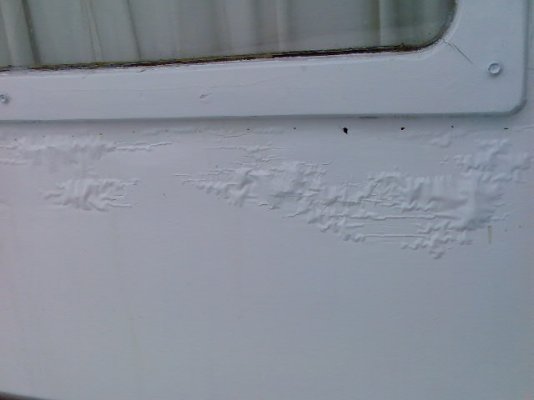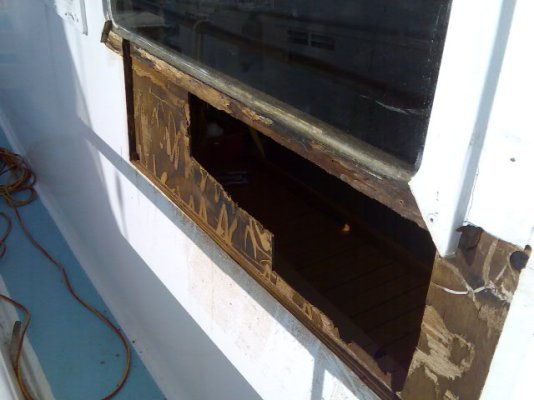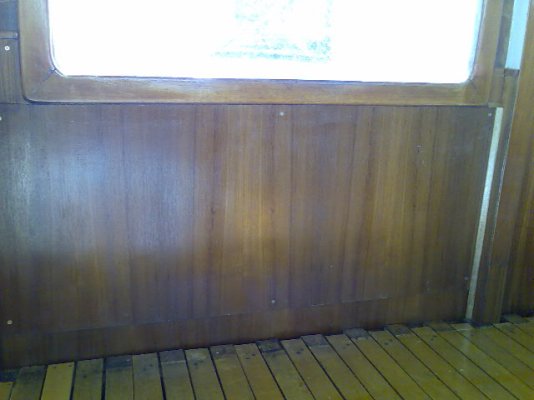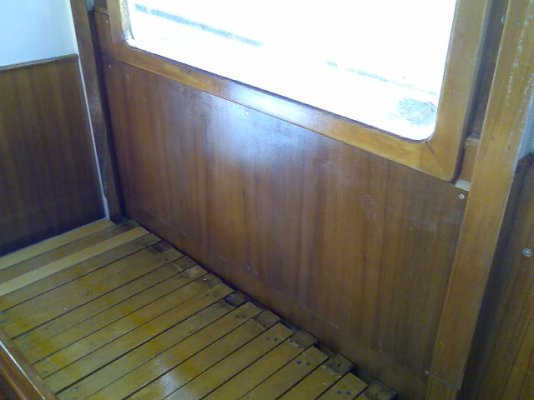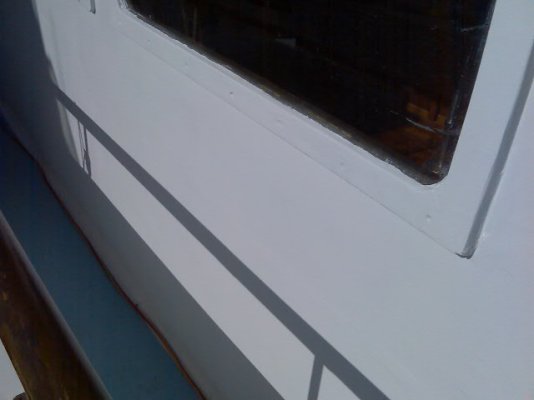You are using an out of date browser. It may not display this or other websites correctly.
You should upgrade or use an alternative browser.
You should upgrade or use an alternative browser.
Previous Boat Owner Stupidity
- Thread starter jeffnick
- Start date
The friendliest place on the web for anyone who enjoys boating.
If you have answers, please help by responding to the unanswered posts.
If you have answers, please help by responding to the unanswered posts.
- Joined
- Jun 25, 2008
- Messages
- 10,104
- Location
- Australia
- Vessel Name
- Now boatless - sold 6/2018
- Vessel Make
- Had a Clipper (CHB) 34
Having just hacked a hole in the side of my cabin to replace a rotted out area under a window, (before and after pics soon), I kinda relate to what this guy says. That pretty much had to be my scenario. The boat is 37 yrs since new, and a lot can happen in that time. On the other hand, a tribute to it is how much has not happened. But he's right. If you want a perfect boat - they don't exist. If you want one with less imperfections, most being invisible, and with all the bells and whistles and real pretty and with not much to do to it, then buy new. You'll still spend heaps 'personallising' it, and getting it just right, adding all the things even a new one still won't have, but all the nooks and crannies, and the engine room will look clean and neat - won't work any better, but will look good. 'course, you'll pay 4 times as much. Take you pick - Pat or Mick.
Baggiolini
Senior Member
Love it, I resemble that post. Can I still be mad about what the previous A-Hole didn't do...like anything. If you can't fix it, hire someone, don't just let the old girl rot.
twiisted71
Guru
- Joined
- Aug 8, 2011
- Messages
- 577
Oh where to start!.....was told during pre-buy looksee that "the water tank must have a hole on the bottom as it will all leak out over about 4 days" Nope it was 1 of the 6, count them 6, splices just in a 8' run from the tank to the water-heater! Or how about the surprises I found when I opened the console under the flybridge helm. There was a HUGE old round TV antenna(#30+) with all the wires cut (your already in there to cut the wires, undo the 4 screws holding the P.O.S. in place making workroom under there none existant), or how about the 3 GPS harnesses wired in to the buss bar, that didn't have a open spot left. Or perhaps the two tank selector valves stuck in the open position as he just "ran off both tanks"! Or how about the two PVC fittings in the A/C plumbing that still had Lowe's stickers! Then there was the typical Mainship commode that had a small holding tank as the base......."I wouldn't put all my weight on that. It's had a crack in the tank for about 8 years now!" The crack was across the top and appeared to stop about 1/2" from the bottom. But he'd just put a new macerator in!!! Oh the list goes on and gets added to every time I tackle another project! Granted they are all small in the grand scheme but add up to lots of aggravation due to a complete lack of pride in having a well kept boat.
Last edited:
psneeld
Guru
amen...hope the ABYC and West marine groupies don't come after you!!!!
O C Diver
Guru
- Joined
- Dec 16, 2010
- Messages
- 12,865
- Location
- USA
- Vessel Name
- Slow Hand
- Vessel Make
- Cherubini Independence 45
Don't get me started! Visualize a fuse panel in the fly bridge run off a fuse panel hidden behind a wall panel run off the main fuse panel. Apparently he had no concept of a bonding system. All bonding wires were cut off all seacocks, and other through hull metal penetrations. Needless to say, there is not an original piece of wire on my boat.
Ted
Ted
RickB
Guru
- Joined
- Oct 20, 2007
- Messages
- 3,804
- Vessel Make
- CHB 48 Zodiac YL 4.2
PVC piping is used and approved by maritime authorities and class societies for non-vital water systems on many (most?) boats these days. There is nothing inherently wrong with using it and the only USCG restraint is with regard to fire and smoke characteristics.
Bonding of through hulls falls into one of two camps, do it or don't do it. Neither method has been proven to be the "correct" way and there is no single "right way" to handle bonding issues.
Accident investigation boards have found that bonding has actually contributed to the failure of through hulls through galvanic corrosion.
Be careful about who and what you call stupid.
Bonding of through hulls falls into one of two camps, do it or don't do it. Neither method has been proven to be the "correct" way and there is no single "right way" to handle bonding issues.
Accident investigation boards have found that bonding has actually contributed to the failure of through hulls through galvanic corrosion.
Be careful about who and what you call stupid.
- Joined
- Jun 25, 2008
- Messages
- 10,104
- Location
- Australia
- Vessel Name
- Now boatless - sold 6/2018
- Vessel Make
- Had a Clipper (CHB) 34
Actually, Rick, on that I have to admit I'm in a quandary. I have gained an impression, (against what I thought was the traditional wisdom), that my bonded sea-cocks and fittings seem to exhibit more galvanic effects than the various un-bonded ones scattered round the boat. Why is it so hard for there to be a definitive answer on this - how hard can it be...?
FF
Guru
- Joined
- Oct 12, 2007
- Messages
- 22,552
Why is it so hard for there to be a definitive answer on this - how hard can it be...?
OPINION,
On boats with minor electric , DC batts no noisemaker , my preference is to NOT bond all the underwater fittings.
We use the green ground line for the 120/240 things at dockside , but its not run to the engine, seacocks, shaft etc.
Worked for 23 years of liveaboard , no pink fittings on haulout.
OPINION,
On boats with minor electric , DC batts no noisemaker , my preference is to NOT bond all the underwater fittings.
We use the green ground line for the 120/240 things at dockside , but its not run to the engine, seacocks, shaft etc.
Worked for 23 years of liveaboard , no pink fittings on haulout.
Last boat, previous owner mounted the macerator pump below the holding tank with no shut off valve between the two. 

RickB
Guru
- Joined
- Oct 20, 2007
- Messages
- 3,804
- Vessel Make
- CHB 48 Zodiac YL 4.2
...below the holding tank with no shut off valve between ...
OK, now THAT is really really stupid!
twiisted71
Guru
- Joined
- Aug 8, 2011
- Messages
- 577
PVC piping is used and approved by maritime authorities and class societies for non-vital water systems on many (most?) boats these days.
Be careful about who and what you call stupid.
Rick, I have no qualms about using h'dware store PVC fittings on my onboard water system. BUT when I saw the fitting (in the link below) screwed into the top of the seawater strainer for the air conditioner, below the waterline, in the obvious area that your foot goes when stepping down into the engine compartment, all the while the P.O. is proudly pointing out the nice new backing plate just below it
 , well I knew I'd have lots of things to go over to make the boat meet "my" standards.
, well I knew I'd have lots of things to go over to make the boat meet "my" standards.Would the A/C chiller water supply be considered "non-vital", or would the location below the water-line make it worthy of a little more robust material?
Shop LASCO 0.75-in dia. 90-Degree PVC Sch 40 Street Elbow at Lowes.com
O C Diver
Guru
- Joined
- Dec 16, 2010
- Messages
- 12,865
- Location
- USA
- Vessel Name
- Slow Hand
- Vessel Make
- Cherubini Independence 45
Had to replace 2 badly pitted seacocks. Think I'll keep my fittings bond together, tied to a grounding plate and a sacrificial zinc. That system has worked perfectly for the last 12 years.Bonding of through hulls falls into one of two camps, do it or don't do it. Neither method has been proven to be the "correct" way and there is no single "right way" to handle bonding issues.
Accident investigation boards have found that bonding has actually contributed to the failure of through hulls through galvanic corrosion.
Be careful about who and what you call stupid.
RickB
Guru
- Joined
- Oct 20, 2007
- Messages
- 3,804
- Vessel Make
- CHB 48 Zodiac YL 4.2
Had to replace 2 badly pitted seacocks.
It doesn't sound like it has worked perfectly if you had to replace them ...
Maybe if they were isolated they wouldn't have pitted ... pitting is usually a different type of corrosion anyway and may not have had anything to do with bonding or not.
The "definitive answer" is that there aren't any. These issues are related to the boat, the water, the marina, and the neighbors.
RickB
Guru
- Joined
- Oct 20, 2007
- Messages
- 3,804
- Vessel Make
- CHB 48 Zodiac YL 4.2
...screwed into the top of the seawater strainer for the air conditioner, below the waterline, in the obvious area that your foot goes when stepping down into the engine compartment ...
Well, that is a bit flaky for sure. But, if it is in a location where it will routinely be stepped on, any fitting should be protected no matter what it is made of.
Just because it is seawater or bleow the waterline doesn't mean it is a critical system. It is downstream of a skin valve so a failure can be isolated ... as long as you know you had a failure but that is a topic for a thread of its own.
This is one of those examples where even the best materials installed improperly or in the wrong location can create a risk. By choosing to use a lightweight plastic fitting the PO just displayed a lack of familiarity with proper materials and practices.
Buying a previously owned boat is much like buying a previously owned home. There is a great likelyhood that repairs or modifications have been done during its lifetime. The older the boat or home, the greater the likelyhood.
In most parts of the USA, home repairs and modifications are governed by building codes and licensing requirements for contractors. These requirements help to insure quality work, but there are many cases where an unquaified homeowner or unlicensed "handyman" has made unsafe repairs or modifications.
For boats, we have the ABYC and USCG giving us "building codes" of a sort, but there are no licensing requirements and no assurances that we as owners or the people we hire to make repairs or modifications are doing the work according to these codes or in a manner that leaves us with a safe boat.
The results can range from the inconvenient such as where the stereo doesn't work properly to the very serious and life threatening such as a fire or explosion.
Having a boat surveyed (or having a home inspected) is a way to sort these issues out. If you know enough about what has been done by a previous owner to determine that it's not a safety issue or that you can easily fix it, fine. If not, you should either pass on the boat or figure the cost of having these issues corrected into the purchase offer.
In most parts of the USA, home repairs and modifications are governed by building codes and licensing requirements for contractors. These requirements help to insure quality work, but there are many cases where an unquaified homeowner or unlicensed "handyman" has made unsafe repairs or modifications.
For boats, we have the ABYC and USCG giving us "building codes" of a sort, but there are no licensing requirements and no assurances that we as owners or the people we hire to make repairs or modifications are doing the work according to these codes or in a manner that leaves us with a safe boat.
The results can range from the inconvenient such as where the stereo doesn't work properly to the very serious and life threatening such as a fire or explosion.
Having a boat surveyed (or having a home inspected) is a way to sort these issues out. If you know enough about what has been done by a previous owner to determine that it's not a safety issue or that you can easily fix it, fine. If not, you should either pass on the boat or figure the cost of having these issues corrected into the purchase offer.
Be careful about who and what you call stupid.
Yeah. Because we could be related to them.

skipperdude
Guru
Everyone has certain abilities when it comes to things done on a boat.
Sometimes things are done as a repair that was needed at the most inopportune time Like at sea.
The old. I'll get around to fixing that right. But for now it works fine.
Found a lot of that on my boat.
Sometimes you just can't seem to find the time.
How many weekends do you get to work on the boat vs use the boat?
That is the question.
Did you buy the boat to work on it or use it?
Sd
Sometimes things are done as a repair that was needed at the most inopportune time Like at sea.
The old. I'll get around to fixing that right. But for now it works fine.
Found a lot of that on my boat.
Sometimes you just can't seem to find the time.
How many weekends do you get to work on the boat vs use the boat?
That is the question.
Did you buy the boat to work on it or use it?
Sd
RickB
Guru
- Joined
- Oct 20, 2007
- Messages
- 3,804
- Vessel Make
- CHB 48 Zodiac YL 4.2
Yeah. Because we could be related to them ...
Or, I'll admit, occasionally even be one of them ...

Everyone has certain abilities when it comes to things done on a boat.
Sometimes things are done as a repair that was needed at the most inopportune time Like at sea.
The old. I'll get around to fixing that right. But for now it works fine.
Found a lot of that on my boat.
Sometimes you just can't seem to find the time.
How many weekends do you get to work on the boat vs use the boat?
That is the question.
Did you buy the boat to work on it or use it?
Sd
When I was working, we often said "If you don't have time to do it right in the first place, how are you going to find time to do it over?"
skipperdude
Guru
I agree when it comes time to work.
Work has more meaning. Others are depending on production.
Working on a boat is really play time.
Like I said. Did you buy it to work on it or use it.
You will find time sooner or later for both.
They really are the same thing.
You can't have one without the other.
Sd
Work has more meaning. Others are depending on production.
Working on a boat is really play time.
Like I said. Did you buy it to work on it or use it.
You will find time sooner or later for both.
They really are the same thing.
You can't have one without the other.
Sd
Last edited:
psneeld
Guru
When I was working, we often said "If you don't have time to do it right in the first place, how are you going to find time to do it over?"
Buy an older boat sometime and you'll find out...as SD points out..,.
O C Diver
Guru
- Joined
- Dec 16, 2010
- Messages
- 12,865
- Location
- USA
- Vessel Name
- Slow Hand
- Vessel Make
- Cherubini Independence 45
You missed my point. The seacocks were pitted when I bought the boat. I replaced the seacocks, installed a proper bonding system, and haven't had a problem in the subsequent 12 years.It doesn't sound like it has worked perfectly if you had to replace them ...
Maybe if they were isolated they wouldn't have pitted ... pitting is usually a different type of corrosion anyway and may not have had anything to do with bonding or not.
Ted
- Joined
- Jun 25, 2008
- Messages
- 10,104
- Location
- Australia
- Vessel Name
- Now boatless - sold 6/2018
- Vessel Make
- Had a Clipper (CHB) 34
Well, rightly or wrongly, I suspect the previous owners tradesmen who already replaced this port side cabin wall 12 odd years ago, MAYBE didn't seal the window sill well enough, and last summer an area of rot developed below the window, which with some trepidation I decided to attack myself. Especially when the yard team quoted ~ $Aus2,500 to do the job, and that did not include lift-out and hard stand time, which they insisted they needed to do it. Emboldened by my son's friend, a cabinetmaker, we attacked the job three weeks ago, and doing as much as possible each weekend since, I finished it today. So....as promised at the top of this thread, here are the before and after pics. I think any subsequent owner would accept the result is acceptable, as I'll freely admit its not perfect. My jobs never are...but they are always STRONG.
Top 2 before - obviously... the rest followed as we progressed...by the end I think it looks ok..?
PS. The cabinetmaker only helped me make the hole - that's all the time he could spare, but that was the bit I was anxious about. Once the gaping hole was made, the rest was pretty straightforward as to what had to be done.
Top 2 before - obviously... the rest followed as we progressed...by the end I think it looks ok..?
PS. The cabinetmaker only helped me make the hole - that's all the time he could spare, but that was the bit I was anxious about. Once the gaping hole was made, the rest was pretty straightforward as to what had to be done.
Attachments
Last edited:
BaltimoreLurker
Curmudgeon
- Joined
- Oct 8, 2007
- Messages
- 2,775
- Location
- USA
- Vessel Name
- Moon Dance
- Vessel Make
- 1974 34' Marine Trader Sedan
I think it looks ok..?
I think it looks great. Have you much experience doing fiberglass work?
- Joined
- Jun 25, 2008
- Messages
- 10,104
- Location
- Australia
- Vessel Name
- Now boatless - sold 6/2018
- Vessel Make
- Had a Clipper (CHB) 34
Minor yacht repairs only Darrell. However, I have to admit as the previous repairs to the cabin on Lotus were not fibreglassed over, just Marine ply and paint, that's all I used here as well. We toyed with the fibreglass outer covering, then realised it would not merge well when the rest of it was not similarly covered. At least it simplified the whole process.I think it looks great. Have you much experience doing fiberglass work?
BaltimoreLurker
Curmudgeon
- Joined
- Oct 8, 2007
- Messages
- 2,775
- Location
- USA
- Vessel Name
- Moon Dance
- Vessel Make
- 1974 34' Marine Trader Sedan
Minor yacht repairs only Darrell. However, I have to admit as the previous repairs to the cabin on Lotus were not fibreglassed over, just Marine ply and paint, that's all I used here as well. We toyed with the fibreglass outer covering, then realised it would not merge well when the rest of it was not similarly covered. At least it simplified the whole process.
Really?! Is the exterior of the entire house, or even large areas, fiberglass free? Just painted marine plywood? I have to admit, the idea never occurred to me. A great solution, elegant in it's simplicity. And, within my skill set.
twiisted71
Guru
- Joined
- Aug 8, 2011
- Messages
- 577
A great solution, elegant in it's simplicity. And, within my skill set.
LOL That is a line my boat's P.O. should have as the quote on his tombstone!
As far as the painted plywood goes, think about the cabins on most wooden hulled real trawlers (commercial variety). Simple, durable, cheap, easy to R/R when repairs are needed

BruceK
Moderator Emeritus
- Joined
- Oct 31, 2011
- Messages
- 13,347
- Vessel Name
- Sojourn
- Vessel Make
- Integrity 386
Peter, it looks good. If the end product is and looks better than before you started, you have succeeded, whether or not perfection was achieved.
What did you use for paint?
My understanding is many early "Taiwanese Trawlers" had ply cabin construction,and that occasionally it occurs in boats normally of all f/g construction. More than one yard built the same boat, construction varied yard to yard, boat to boat. BruceK
What did you use for paint?
My understanding is many early "Taiwanese Trawlers" had ply cabin construction,and that occasionally it occurs in boats normally of all f/g construction. More than one yard built the same boat, construction varied yard to yard, boat to boat. BruceK
- Joined
- Jun 25, 2008
- Messages
- 10,104
- Location
- Australia
- Vessel Name
- Now boatless - sold 6/2018
- Vessel Make
- Had a Clipper (CHB) 34
Yes, it looks like almost the entire superstructure is painted marine ply. The paint I used was International (Interlux), Snow White colour Toplac. Matches the two pack International Perfection Snow White of the hull.
Similar threads
- Replies
- 20
- Views
- 1K

